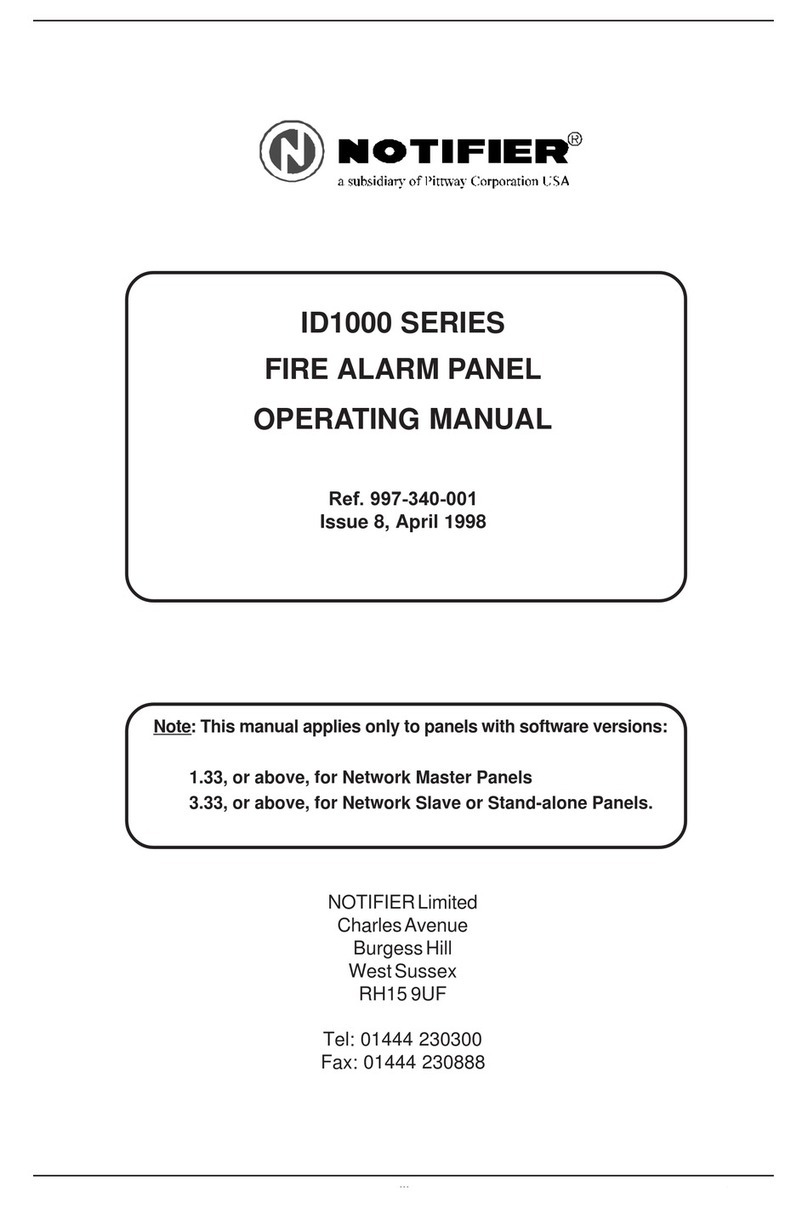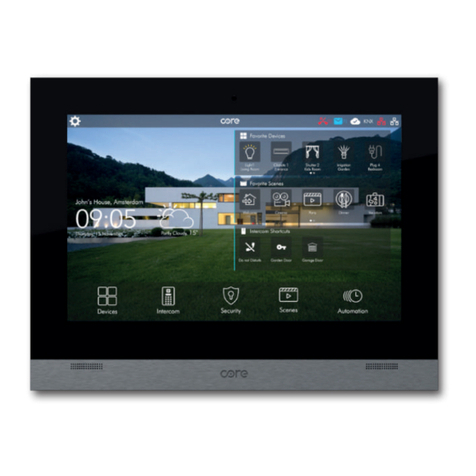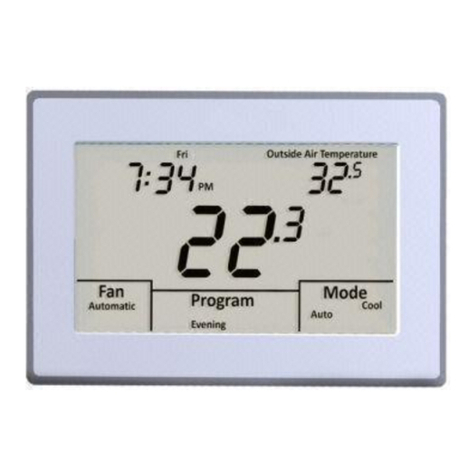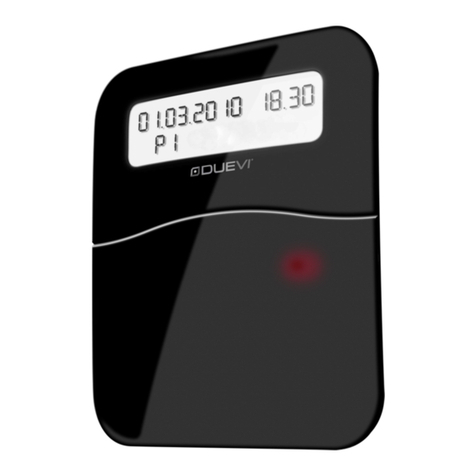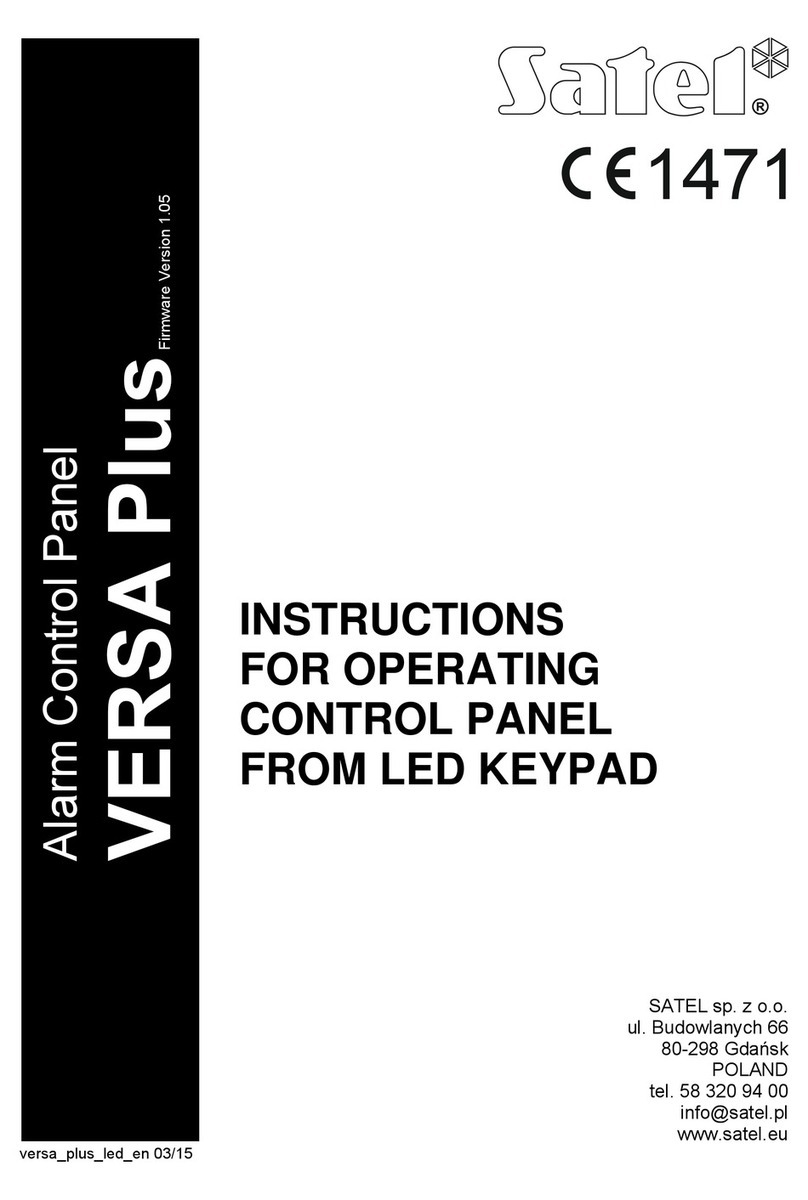Pittway System Sensor PDRP-1001 User manual

PDRP-1001/PDRP-1001A
DELUGE ■■
■■
■PREACTION CONTROL PANEL
Doc.# 50734 ECN 97-514
ZONE 1
ZONE 2
WATERFLOW
SUPERVISORY
AC POWER
SYSTEM ALARM
RELEASE
SUPERVISORY
SYSTEM
TROUBLE
TONE
SILENCE ALARM
SILENCE ALARM
ACTIVATE RESET
CIRCUIT
TROUBLE
POWER
TROUBLE
ALARM
SILENCED
A Pittway Company

PDRP-1001/PDRP-1001A Document 50734 Rev B 12/21/97
2

PDRP-1001/PDRP-1001A Document 50734 RevB 12/21/97
3
Table of Contents
I NFPA Standards ..............................................................4
II Additional Information ...................................................4
1.0 The PDRP-1001/PDRP-1001A .......................................................5
1.1 Features........................................................................................................ 5
1.2 Circuits.......................................................................................................... 5
1.3 Optional Boards ............................................................................................ 7
1.4 Remote Annunciator ..................................................................................... 8
1.5 Optional Meters............................................................................................. 8
1.6 Specifications................................................................................................ 9
2.0 System Operation .........................................................................11
2.1 System Status LEDs ................................................................................... 11
2.2 Control Switches......................................................................................... 12
2.3 Zone Status LEDs....................................................................................... 12
2.4 Supervisory................................................................................................. 13
2.5 Zone Disable .............................................................................................. 13
2.6 Last Event Recall........................................................................................ 13
3.0 Installation Procedure ..................................................................14
3.1 General ....................................................................................................... 14
3.2 Initiating Device Circuits ............................................................................. 15
3.3 4-Wire Smoke Detector Connections.......................................................... 16
3.4 Output Circuits ............................................................................................ 17
3.5 Power.......................................................................................................... 18
3.6 Optional Modules........................................................................................ 20
3.7 Dip Switch Location and Descriptions ........................................................ 25
3.8 Setting Mode of Operation .......................................................................... 26
Appendix A: Power Calculations......................................................27
Appendix B: Device Compatibility Chart .........................................29
Appendix C: NFPA Standard Specific Requirements ....................33
Troubleshooting Table ........................................................................38

PDRP-1001/PDRP-1001A Document 50734 Rev B 12/21/97
4
INFPA Standards
This control panel complies with the following NFPA standards:
NFPA 13 Sprinkler Systems
NFPA 15 Water Spray Systems
NFPA16Foam-WaterDelugeandFoam-WaterSpraySystems
NFPA 72 Central Station Signaling Systems (Automatic, Manual, and Waterflow). Protected
PremisesUnit(RequiresNOTI-FIRE911ACDACTorMS5012SlaveCommunicator).*
NFPA 72 Local (Automatic, Manual, Waterflow and Sprinkler Supervisory) Fire Alarm Systems.
NFPA 72 Auxiliary (Automatic, Manual, and Waterflow) Fire Alarm Systems. (Requires 4XTM.)
NFPA 72 Remote Station (Automatic, Manual, and Waterflow) Fire Alarm Systems. (Requires
4XTM or NOTI•FIRE 911AC DACT.) *
* Applications which require the NOTI-FIRE 911AC is not FM approved.
II Additional Information
Note: Before proceeding, the installer should be familiar with the following documents and standards:
NFPAStandards:
NFPA 13 Installation of Sprinkler Systems
NFPA 15 Water Spray Fixed Systems
NFPA16DelugeFoam-WaterSprinklerandFoam-WaterSpraySystems
NFPA 72 Installation, Maintenance, and Use of Central Station Signaling Systems
NFPA 72 Local, Auxiliary, Remote Station and Proprietary Fire Alarm Systems
NFPA 72 Automatic Fire Detectors
NFPA 72 Installation, Maintenance, and Use of Notification Appliances for Fire Alarm Systems
NFPA 72 Testing Procedures for Signaling Systems
UnderwritersLaboratoriesDocuments:
UL 38 Manually Actuated Signaling Boxes
UL 217 Smoke Detectors, Single and Multiple Station
UL 228 Door Closers - Holders for Fire Alarm Systems
UL 268 Smoke Detectors for Fire Alarm Systems
UL 268A Smoke Detectors for Duct Applications
UL 346 Waterflow Indicators for Fire Alarm Systems
UL464AudibleSignalingAppliances
UL 521 Heat Detectors for Fire Alarm Systems
UL 864 Standard for Control Units for Fire Alarm Systems
UL 1481 Power Supplies for Fire Alarm Systems
UL1638 VisualSignalingAppliances
UL1971SignalingDevicesfortheHearingImpaired
CAN/ULC-S524-M91Standard forInstallationof FireAlarmSystems
CAN/ULC-S527-M87StandardforControlUnitsforFireAlarmSystems
Other:
NECArticle300WiringMethods
NEC Article 760 Fire Alarm Systems
ApplicableLocalandStateBuildingCodes
Requirementsof the Local AuthorityHavingJurisdiction
NotifierDeviceCompatibilityDocument,15378.
ADA Americans with Disabilities Act

PDRP-1001/PDRP-1001A Document 50734 RevB 12/21/97
5
1.0 ThePDRP-1001/PDRP-1001A
1.1 Features
• Microprocessor-controlled
• Alarmandtroubleresound
• Four Style B/D Initiating Device Circuits
• Two Style Y/Z Notification Appliance Circuits
• Two Style Y Release Circuits
• Generalalarmandtroublerelays
• Optionalmodulefor4zone/functionrelays(4XZM)
• Optional transmitter module (4XTM). Complies with
NFPA 72 Auxiliary and Remote Station Fire Alarm
Systems.
• Optionalvolt/ampmetermodule(4XMM)
• Optionalsupervisedremoteannunciator
(RZA-4X). RequiresLEDInterfaceModule(4XLM)
• Optionaldigitalcommunicator(NOTI•FIRE911AC).*
• ComplieswithNFPA72CentralStationandNFPA72
Remote Station Fire Alarm Systems.
• DesignedforsprinklerstandardsNFPA13,15,and16.
• Disable/enablecontrolsperinitiatingzone.
• Last Event Recall
• Battery/Earthfault supervision
• Fuseprotection on all Notification/Release Circuits
• RMSregulatedoutputpower,2.25amps
• 7amp/hourto15amp/hourbatteryoptions,
up to 90 hours standby
• Resettable and non-resettable regulated
poweroutputs
• Extensivetransient protection
• Watchdog timer to supervise microproces-
sor(includes MICRO FAIL LED)
• Output circuits protected against false
activations.
• Slide-inzoneidentification labels
• Steel cabinet 14.5" wide by 16" high by 5"
deep
• Dead-frontdresspaneloption(DP-4X)
• Trimringforflushmountbetween16"center
studs(TR-4XR)
• Cross-zone(double-interlock)option
• Municipal Box output.
• InterfaceModule(4XLM)
• Dualhazardoperation
• Adjustabledischargetimer
* Applications which require the NOTI-FIRE 911AC is not FM approved.
1.2 Circuits
Input Circuits
Manual Release/Detector Circuit 1 (Style B/D)
Detector Circuit 2 (Style B/D)
Waterflow (Style B/D)
Supervisory (Style B/D)
Output circuits (optional auxiliary relay module (4XZM) tracks these four circuits)
Alarm/Waterflow Bell (Style Y/Z)
Waterflow/Supervisory Bell (Style Y/Z)
Releasing Circuit 1 (Style Y)
Supervisory Bell/Release Circuit 2 (Style Y)
Front Panel Control Switches
Switch 1 Tone Silence
Switch 2 Alarm Silence
Switch 3 Alarm Activate
Switch 4 System Reset

PDRP-1001/PDRP-1001A Document 50734 Rev B 12/21/97
6
Figure 1.0-1: PDRP-1001/PDRP-1001A Installation Diagram

PDRP-1001/PDRP-1001A Document 50734 RevB 12/21/97
7
1.3 Optional Boards
The PDRP-1001/PDRP-1001A has mounting slots for two option boards. Any two of the three option
modules may be installed.
TransmitterModule(4XTMNOTIFIER)
The Transmitter Module provides a supervised output for local energy
municipalbox transmitter (for NFPA72-1993Auxiliary Fire Alarm System)
and alarm and trouble reverse polarity circuits (for NFPA 72-1993 Remote
StationFireAlarmSystem). AlsoincludedisaDISABLEswitchanddisable
troubleLED.
Asajumperoption,the alarm reversepolaritycircuitwillopen on troubleifnoalarm
exists.
LEDInterfaceModule(4XLMNOTIFIER)
The LED Interface Module supports the RZA-4X Remote Annunciator
module.Annunciatorwiringissupervisedforopenconditionsbythismodule.
TheAnnunciatorDriverModulemountstothemainboard,occupyingoneof
the two option connectors.
ZoneRelay Module (4XZMNOTIFIER)
TheZone Relay module provides Form-Ccontactsfor the following:
• Alarm/WaterflowBell
• Waterflow/SupervisoryBell
• ReleasingCircuit1
• SupervisoryBell/Release Circuit2
• System Alarm
• SystemTrouble
As a jumper option, the first four relays described above can be made silenceable.

PDRP-1001/PDRP-1001A Document 50734 Rev B 12/21/97
8
LEDInterfaceModule(4XLMNOTIFIER)
Maximumvoltage/current,eachoutput:27.6V/8mA.
Note: Outputs are power limited.
ZoneRelay Module (4XZMNOTIFIER)
Dry Form-C contacts rated: 2.0 amps @ 30 VDC (resistive), 0.5 amps @ 30 VAC (resistive).
1.4 Remote Annunciator
RemoteAnnunciator(RZA-4XNOTIFIER)
TheRemoteAnnunciatormountsonastandardsingle-gangbox,andprovidesLED
indication of the following:
•Alarm/WaterflowBell(red)
•Waterflow/SupervisoryBell(red)
•ReleasingCircuit1(red)
•SupervisoryBell/ReleaseCircuit2(red)
•SystemTroubleLED(yellow)
A Local Trouble Sounder and Silence Switch are also provided. All LED wiring is
supervised for open conditions. Any open condition will cause the System Trouble
LED to illuminate.
Note: The Remote Annunciator requires the use of an LED Interface module (4XLM).
1.5 Optional Meters
Voltage,CurrentMeters (4XMM NOTIFIER)
The Meter Module provides a voltmeter to measure the voltage across the
batteriesandanammetertomeasurethechargingcurrenttothe batteries.The
meters are provided as a assembly that mounts to the lower left corner of the
cabinet.
TransmitterModule(4XTMNOTIFIER)
For Local Energy Municipal Box service (NFPA 72 Auxiliary Fire Alarm System)
Supervisory current: 5.0 mA.
Tripcurrent: 0.35 amps(subtractedfromNotification Appliancepower).
CoilVoltage: 3.65 VDC.
Coil resistance: 14.6 ohms.
Maximum allowable wire resistance between panel and trip coil: 3 ohms.
Municipal Box wiring can leave the building.
ForRemote Stationservice (NFPA72 RemoteStation FireAlarmSystem):
Maximum load for each circuit: 10 mA.
Reverse polarity output voltage: 24 VDC.
RemoteAlarm andRemoteTrouble wiringcanleave thebuilding.

PDRP-1001/PDRP-1001A Document 50734 RevB 12/21/97
9
AC Circuit
Breaker
1.6 Specifications
ACPower
ForPDRP-1001/PDRP-1001A:120VAC,50/60Hz,1.2amps
Wire size: minimum #14 AWG with 600V insulation
Battery(leadacidonly)
Maximum Charging Circuit: 27.6V, 1.5 amps
Maximum Battery Capacity: 15 AH. (Batteries larger than 12 AH require Notifier
#BB-17 or other UL listed battery cabinet.)
InitiatingDeviceCircuits
Power-limitedcircuitry
Operation: Style B (Class B)/ Style D (Class A)
NormalOperatingVoltage: 24VDC (ripple=1.0Vpeak-to-peak)
Alarm current: 15 mA minimum
Short circuit current: 40 mA maximum
Maximum detector current in standby: 2 mA (max) per zone
Maximum loop resistance: 200 ohms
End-of-line resistor: 4.7K, 1/2-Watt (NOTIFIER part # 71252 UL listed)
Detector loop current is sufficient to ensure operation of one alarmed detector per zone.
Supervisorycurrent:5mA(includingend-of-lineresistor)
NotificationApplianceandReleasingCircuits
Power-limitedcircuitry
Maximumallowablevoltagedropduetowiring:2VDC
NormalOperatingVoltage: 24VDC
Total current available to all external devices: 2.25 amps.
Maximum signaling current per circuit: 1.5 amps
End-of-line resistor: 4.7K, 1/2-Watt (NOTIFIER part # 71252 UL listed)
Alarmand TroubleRelays
Dry Form-C contacts rated: 2.0 amps @ 30 VDC (resistive), 0.5 amps @ 30 VAC (resistive).
All relays must be connected to a power-limited power supply.
Four-wireSmokeDetectorPower
Up to 200 mA is available for powering 4-wire smoke detectors.
Maximum ripple voltage: 1.0 V p/p
Non-resettablePower
TotalDC currentavailablefromthis outputisupto 200mA(subtractedfrom four-wiresmokepower).
Maximum ripple voltage: 1.0 V p/p
RMSRegulatedPower
Total DC current available for powering external devices is 0.5 amp (subtracted from 2.25
amps available to notification appliance circuits).
Maximum ripple voltage: 100 mV p/p
Note: For device compatibility data, refer to the Device Compatibility Chart, Appendix B.
P1 P2 P3 P4
Output Circuit PTCs

PDRP-1001/PDRP-1001A Document 50734 Rev B 12/21/97
10
Cabinet = 5.375"
Backbox = 4.750"
Door = 16.125"
Backbox = 16"
Door = 14.625"
Backbox = 14.5"
Figure 1.6-1: Cabinet Dimensions
OptionalTrimRing
TR-4XR

PDRP-1001/PDRP-1001A Document 50734 RevB 12/21/97
11
2.0 System Operation
2.1 System Status LEDs
Alarm,TroubleandSupervisoryLEDswillflashonandoffuntiltheevent(s)hasbeenacknowledged(TONE
or ALARM SILENCE), at which point the LED will illuminate steadily.
ACPOWER
Green LED that illuminates steadily to indicate
presenceofACpower.
SYSTEMALARM
Red LED that flashes when an alarm occurs.
RELEASE
Red LED that illuminates steadily when release
occurs.
After the
Discharge Timer has expired, the LED will flash.
SUPERVISORY
Yellow LED that flashes upon activation of a
supervisory device (such as tamper switch) on
Zone4.
SYSTEMTROUBLE
YellowLEDthatflashesforanytroublecondition,
includingthoseassociated with option boards.
CIRCUITTROUBLE
YellowLEDthatflashesfortroubleconditionson
outputcircuits(notificationandreleasingcircuits).
ALARMSILENCED
Yellow LED that illuminates steadily when the
ALARMSILENCE switch has beenpushedafter
analarm.
POWERTROUBLE
Yellow LED that flashes for low or disconnected
batteries and earth fault conditions.
BATT
Yellow LED that illuminates steadily on
motherboardwhenbattery is low ornotdetected
(notvisiblethroughdoor).
EARTH
Yellow LED that illuminates steadily on
motherboardduringagroundfaultcondition(not
visiblethroughdoor).
MICROFAIL
YellowLEDthatilluminatesonmotherboardwhen
watchdog timer detects microprocessor failure
(notvisiblethroughdoor).

PDRP-1001/PDRP-1001A Document 50734 Rev B 12/21/97
12
2.2 Control Switches
ToneSilence
Acknowledgealarms,troublesandsupervisories. Thepanelhasalarm
and trouble resound with LED flash of new conditions. The flashing
trouble LED(s) illuminate steadily on TONE SILENCE and the piezo
soundersilences. Asecondtroublewillresoundthepiezo. Thepiezohas
threedistinctsoundsforalarm,trouble,andsupervisory.Troublecondi-
tions are self restoring. Alarms and supervisories latch and require
RESET to clear.
AlarmSilence
Acknowledge for alarms and supervisories. The ALARM SILENCE
switch will silence the local piezo, change any flashing alarm LEDs to
steady,andturnoffthenotificationappliancecircuits(nottheReleasing
Circuits). The“ALARM SILENCED”LEDwillilluminate. Alarmsilence
is a latching function and requires a RESET to clear.
Note: Releasing Circuits will turn off only if Discharge timer criteria is satisfied
see "Setting Mode of Operation".
AlarmActivate
The ALARM ACTIVATE switch may be used to activate Notification
Appliance Circuits. ALARM ACTIVATE also activates the System
Alarmrelay. ALARMACTIVATEisalatchingfunction. PressingALARM
SILENCEsilencesthenotificationappliancecircuitsandSystemAlarm
Relayand lightstheAlarm SilencedLED. PressingRESETreturns the
system to normal.
SystemReset
The RESET switch breaks power to all initiating device circuits, 4-wire
smoke power and option boards and will clear any activated output
circuits. Ifanyalarmortroublestillexistsafterreset,theywillreactivate
thepanel. HoldingRESETdownwillperformaLAMPTESTfunctionand
will activate the piezo sounder.
2.3 Zone Status LEDs
Thealarmand/ortroubleLED(s)willflashuntilthe
event(s) has been acknowledged (TONE or
ALARM SILENCE), at which point the LED(s) will
illuminatesteadily. ZONE 1
ZONE 2
WATERFLOW
SUPERVISORY
ALARM LED
TROUBLE LED
ALARM LED
TROUBLE LED
ALARM LED
TROUBLE LED
(NOT USED)
TROUBLE LED

PDRP-1001/PDRP-1001A Document 50734 RevB 12/21/97
13
2.4 Supervisory
Zone4isalwaysusedformonitoringsupervisorydevices(suchasvalvetamperswitches). Ashortcircuit
onthiszone(activationofaN.O.contact)willcausethesupervisoryLEDandthezone4yellowLEDtoflash.
The piezo sounder will generate a unique Pressing TONE SILENCE will silence the piezo and cause the
supervisory LED to illuminate steadily,
but the Zone 4 Trouble LED will continue to flash
. Supervisory
signalslatchand require RESET toclear. TheALARMSILENCEswitch will silencethepiezo,causethe
supervisoryLEDtoilluminatesteadilyandturnofftheSupervisoryNotificationApplianceCircuit. Anopen
circuit on Zone 4 will be reported as a zone trouble.
2.5 Zone Disable
Ifazonehasbeendisabled,analarmthatoccursonthatzonewillflash
theredzoneLED,butneitherthepiezonoranyoutputcircuitwillactivate.
Ifbothpowersourcesare removed from the system, all zones willbere-
enabled upon restoration of power. Disable status will be lost.
The Zone Disable routine makes use of the four panel switches
as follows:
1) Press and hold in the TONE SILENCE switch.
2) With the TONE SILENCE switch held in, press (in sequence) the ALARM
SILENCE switch, the ALARM ACTIVATE switch, and then the RESET
switch.
3) The Zone 1 Alarm LED will flash.
4) To disable Zone 1, press the RESET switch. The Zone 1 yellow LED will light to
show that the zone is disabled.
Note: The RESET switch toggles disable status for the selected zone.
5) To select the next zone, press the ALARM SILENCE switch.
6) To select the previous zone, press the ALARM ACTIVATE switch.
7) When disable selections are complete, release the TONE SILENCE switch.
If any zone has been disabled, the trouble relay will activate and System Trouble LED will flash.
2.6 Last Event Recall
LastEventRecallallowstheusertodisplaythepreviouspanelstatus. TheLastEventRecallmakesuse
of the four panel switches as follows:
1) Press and hold in the TONE SILENCE switch.
2) With the TONE SILENCE switch held in, press (in sequence) the RESET
switch, the ALARM ACTIVATE switch, and then the ALARM SILENCE switch.
3) Last Event is displayed.
4) Releasethe TONE SILENCE switchtoreturn to normal operation.
Note: To clear the Last Event buffer, press RESET twice.

PDRP-1001/PDRP-1001A Document 50734 Rev B 12/21/97
14
3.1 General
Carefullyunpackthesystemandcheckforshippingdamage.Mountthe cabinetinaclean,dry,vibration-
freearea inwhichextremetemperatures arenotencountered. Thelocation shouldbereadilyaccessible
withsufficientroomforeasyinstallationandmaintenance. Locatethetopofthecabinetapproximatelyfive
feetabovethefloorwiththehingemounting on the left. Determine the number of conductors required for
thedevicestobeemployed. Pullrequiredconductorsintotheboxthroughtheknockoutprovided. Allwiring
should be in accordance with the National and/or Local codes for fire alarm systems.
ULPower Limited WiringRequirements
Powerlimitedandnon-powerlimitedcircuitwiringmustremainseparatedinthecabinet. Allpowerlimited
circuit wiring must remain at least 0.25" away from any non-power limited circuit wiring. Furthermore, all
power limited circuit wiring and non-power limited circuit wiring must enter and exit the cabinet through
differentknockouts and/or conduits. Atypicalwiringdiagram forthePDRP-1001/PDRP-1001Ais shown
below.
3.0 Installation Procedure
Figure 3.1-1: Typical Wiring Diagram for UL Power-Limited Requirements
PC Board
AC Power Power
Limited
Circuit
Non-Power
Limited
Circuit
Initiating Circuits
Bell Circuits
Relays
Power Limited
Circuits
Non-Power
Limited Circuits
Power Limited
Circuits

PDRP-1001/PDRP-1001A Document 50734 RevB 12/21/97
15
3.2 Initiating Device Circuits
Zones
Wire all alarm initiating devices sequentially for proper supervision. Initiating devices include: heat,
photoelectric,andionizationtypedetectors;andwaterflowalarmdevices.RefertotheDeviceCompatibility
Chart,AppendixB.
Notes:
1) Observe polarity when connecting polarized devices.
2) All circuits are supervised and power limited.
3) Leave Dummy Load (provided) on all unused circuits.
Figure 3-2: Ffffff
Figure 3.2-1: Example of Initiating Device Circuits
IN #1 IN #2 IN #3 IN #4
1 2 3 4 5 6 7 8 9 10 11 12 13 14 15 16
B+ A+ A- B- B+ A+ A- B- B+ A+ A- B- B+ A+ A- B-
TB4
Style B
Initiating Device
Circuit
Style D
Initiating Device
Circuit
Heat
Detector
Two-wire
Smoke Detector
Manual
Release
Normally Open
Waterflow
Devices or
Pressure
Switches
Normally Open
Tamper Switches
or Pressure
Switches
+-
+-
+
-
+
-
+-
+-
Style B
Supervisory
Circuit
4.7K,1/2-Watt
(NOTIFIERpart#71252,
ULlisted)
4.7K,1/2-Watt
(NOTIFIERpart#71252,
ULlisted)

PDRP-1001/PDRP-1001A Document 50734 Rev B 12/21/97
16
Notes on Style B and Style D field wiring:
1) ThePower Supervision Relay coil leads must be connected tothe lastdetector base24V screw terminals.
2) Calculation of the maximum allowable resistance in the 24VDC detector power wiring:
Where:
RMAX is the maximum resistance of the 24V wires.
VOM is the minimum operating voltage of the detector or end-of-line relay, whichever is
greater, in volts.
N is the total number of detectors on the 24V supply loop.
ISis the detector current in standby.
NAis the number of detectors on the 24V power loop which must function at the same
time in alarm.
ISis the detector current in alarm.
IRis the end-of-line relay current.
3.3 4-Wire Smoke Detector Connections
24 VDC (+)
Common (-)
IDC(+)
IDC(-)
Red
Black
24 VDC (+)
Common (-)
IDC(+)
IDC(-)
UL-listed 24 VDC
Four-Wire Smoke Detectors
UL Listed
4.7K, 1/2-Watt
ELR
TB1
123 4
+ - TB4
123 4
B+ A+ A- B-
+24VR
A maximum of 200mA is available from the
+24VDC 4-wire smoke detector power cir-
cuitonTB1terminals3and4.Anypowerthat
is drawn from the +24VDC Non-Resettable
Power on TB2 terminals 1 and 2 must be
subtracted from available 4-wire detector
power. See Sections
"Specifications"
and
"Power"
.
IN #1
Style B Initiating Device Circuit
Initiating Device Circuits 1, 2, 3, or 4
can be used. Style D wiring can also be
employed.
Listed
Power
Supervision
Relay
Refer to the Device Compatibility Chart (Appendix B), for suitable 4-wire smoke detectors.
Figure 3.3-1: Diagram of connections for a 4-Wire Smoke Detector
RMAX = (20.6 - VOM)
(N x IS) + (NAx IA) + (IR)

PDRP-1001/PDRP-1001A Document 50734 RevB 12/21/97
17
3.4 Output Circuits
NotificationApplianceCircuits
This control panel can provide two Style Y/Z Notification Appliance Circuits and two Style Y Releasing
Circuits (see Section
"Dip Switch Location and Descriptions"
for DIP switch configuration). Each circuit
iscapableof1.5ampsofcurrent. Totalcurrentdrawnfromallfourcircuitscannotexceed2.25amps.Refer
to the Device Compatibility Chart, Appendix B. Circuits are supervised and power-limited.
Note: Wiring must be configured to maintain a minimum voltage of 20.4V on release circuits. Calculation
of maximum allowable resistance:
RMAX = 20.6V- 20.4V
IS
Where: RMAX = maximum allowable resistance of wiring IS= solenoid current
3 45 678 910111213141516
Polarized Bell
Polarized Strobe
Polarized Horn
B+ A+ A- B- B+ A+ A- B- NC B+ B- NC B+ B-
Style Z
Notification
Appliance Circuit
Style Y
Notification
Appliance Circuit
B+ A+ A- B- B+ A+ A- B- B+ B- B+
4.7K, 1/4-Watt
UL-listed End-of-Line device
Dummy Load all unused
Notification Appliance Circuits Dummy Load all unused
Releasing Circuits
4.7K, 1/2-Watt
(part # 71252, UL listed)
4.7K, 1/4-Watt
UL-listed End-of-Line device
TB2
UL listed & FM approved
Solenoid Release Valves
(see Device Compatibility
Document)
Releasing Circuits
No Connection
No Connection
Figure 3.4-1: Notification Appliance Circuits
OUT #1 OUT #2 OUT #3 OUT #4

PDRP-1001/PDRP-1001A Document 50734 Rev B 12/21/97
18
3.5 Power
CAUTION: Severaldifferentsourcesofpowercanbeconnectedtothispanel. Disconnect
all sources of power before servicing. The panel and associated equipment may be
damaged by removing and/or inserting cards, modules, or interconnecting cables while
this unit is energized.
This output is not suitable for
powering devices requiring fil-
tered, regulated DC power.
The combined current draws from the Resettable and Non-Resettable
outputs cannot exceed 200 mA.
Alarm Relay
One Form-C dry alarm contact is provided in the basic panel for controlling supplementary devices. It is
rated2ampsat30VDCand0.5ampsat30VAC(resistive)andisnon-silenceablewhenanalarmoccurs.
See below for terminal location.
Trouble Relay
One Form-C dry trouble contact is provided in the basic panel for controlling supplementary devices. It
is rated 2 amps at 30 VDC and 0.5 amps at 30 VAC (resistive) and will silence when trouble condition is
cleared. See below for terminal location.
Note: The alarm and trouble Form-C dry contact relays must be power limited relays. They
must be wired from one of the 24V power limited terminals as shown in the figure below
or a comparable UL listed power limited power supply. ALARM TROUBLE
NO NC C NO NC C
Alarm Trouble
Figure 3.4-2: Alarm/Trouble Coils and Contacts.
+24VU +24VR +24VNR
+ - + - + -
- - -
- - -
- - -
or or
1 2 345 6
1 2 3 4 1 2
TB1 TB2 TB3
RMS-Regulated Power
24 VDC power for inductive-type
devices such as door holders can
be connected to TB1 terminals 1(+)
and 2 (-).
+24VU +24VR +24VNR
+ - + - + -
4-Wire Smoke Detector Power
24 VDC filtered, regulated, resettable
power for 4-wire smoke detectors can
be obtained from TB1 Terminals 3 (+)
and 4 (-).
Non-resettable Power
24 VDC filtered, regulated, non-reset-
table power can be drawn from TB2
Terminals 1 (+) and 2 (-).
1 2 3 4
Figure 3.5-1: Diagram of Power Terminals
TB1
1 2
TB2

PDRP-1001/PDRP-1001A Document 50734 RevB 12/21/97
19
Voltmeter/Ammeter
To monitor battery voltage and battery charging current, a 4XMM (NOTIFIER) is required. To install the
powermetermodule,removethejumperlabeled"AMP"andconnectcableassemblyP2topinconnector
J2andcable assembly P3 to pinconnector J3onthemainboard. Secure the 4XMM to thebackbox with
the two screws provided. On some models, it will be necessary to install the meter bracket with the nuts
andboltsprovided.
J2
J3
ACPower
Primary power required for the PDRP-1001/PDRP-1001A panel is 120 VAC, 50/60 Hz, 1.2 amps.
Overcurrent protection for this circuit must comply with Article 760 of the National Electrical Code (NEC)
and/or local codes. Use #14 AWG or larger wire with 600 volt rating.
BatteryPower
Observepolaritywhenconnectingbattery. ConnectbatterycabletoJ9onthemainboardusingtheplug-
in connector provided. See Appendix A for calculation of correct battery rating.
CAUTION: Batteries contain sulfuric acid which can cause severe burns to the skin and
eyes,andcandestroyfabrics. Ifcontactismadewithsulfuricacid,immediatelyflushskin
or eyes with water for 15 minutes and seek immediate medical attention.
Figure 3.5-2: Diagram of the 4XMM Voltmeter Connected to the Main Board
J9

PDRP-1001/PDRP-1001A Document 50734 Rev B 12/21/97
20
3.6 Optional Modules
Thefire control panelhastwomodule connectors-J5and J8. Threemodulesareavailable for thepanel
andtheycanbeusedinanycombination,includingduplicatemodules. Thecorrespondingoptionjumper
must be cut before installation of an optional module, to enable module supervision.
J7
J8
OPT1 Jumper
Cut to install
module on J5.
Notes:
1) Optional 4XLM module for an RZA-4X Annunciator must be installed on J7 and J8 only.
2) 4XTM and 4XZM modules can be installed in either location.
Figure 3.6-1: Optional Panel Modules
OPT2 Jumper
Cut to install
module on J8.
J4
J5
This manual suits for next models
1
Table of contents
Other Pittway Control Panel manuals
Popular Control Panel manuals by other brands
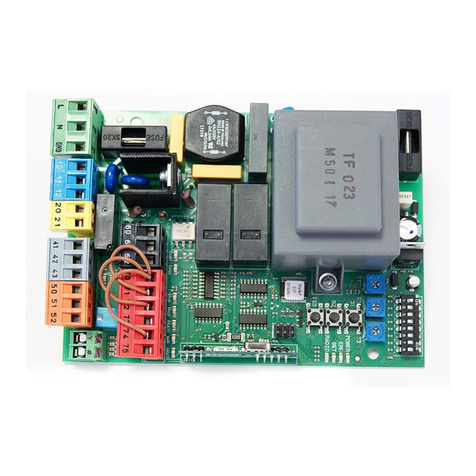
BFT
BFT SHYRA AC F SL installation manual
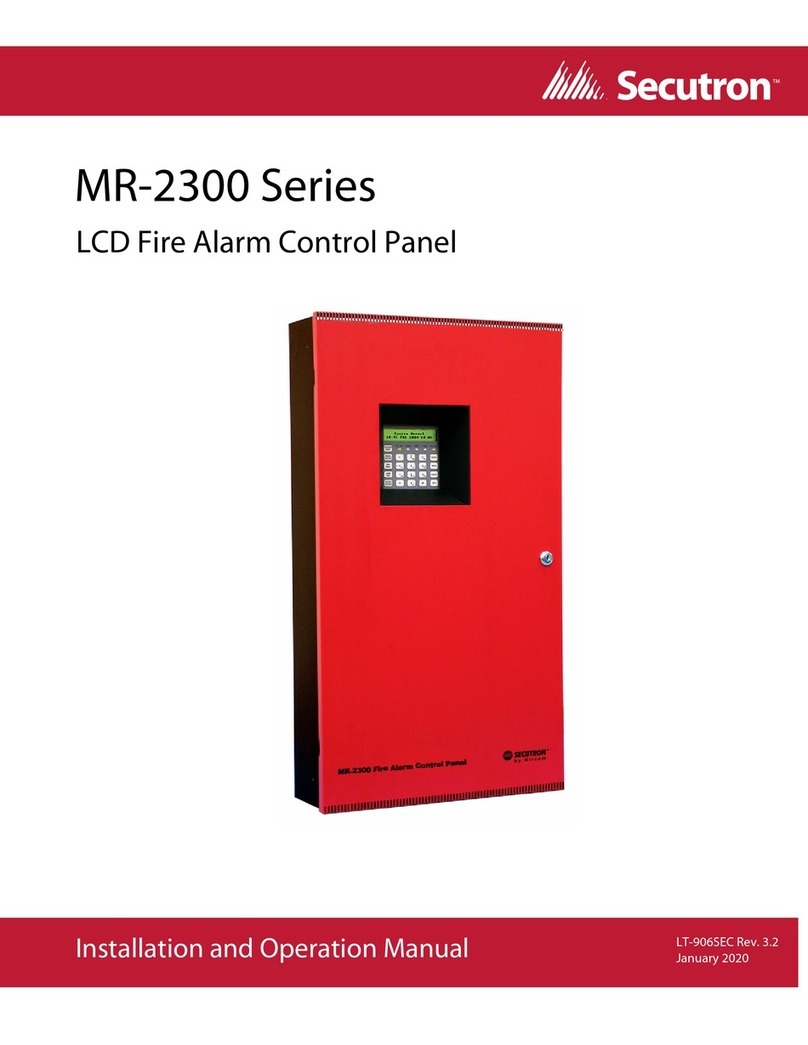
Secutron
Secutron MR-2300 series Installation and operation manual
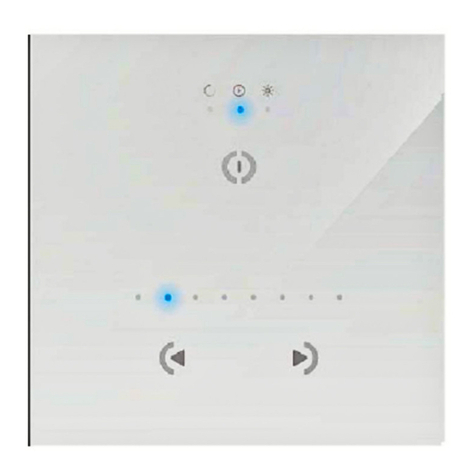
Coloronix
Coloronix SCC3 Manual guide

Panasonic
Panasonic AWRP501 - HYBRID CONTROL PANEL Service manual
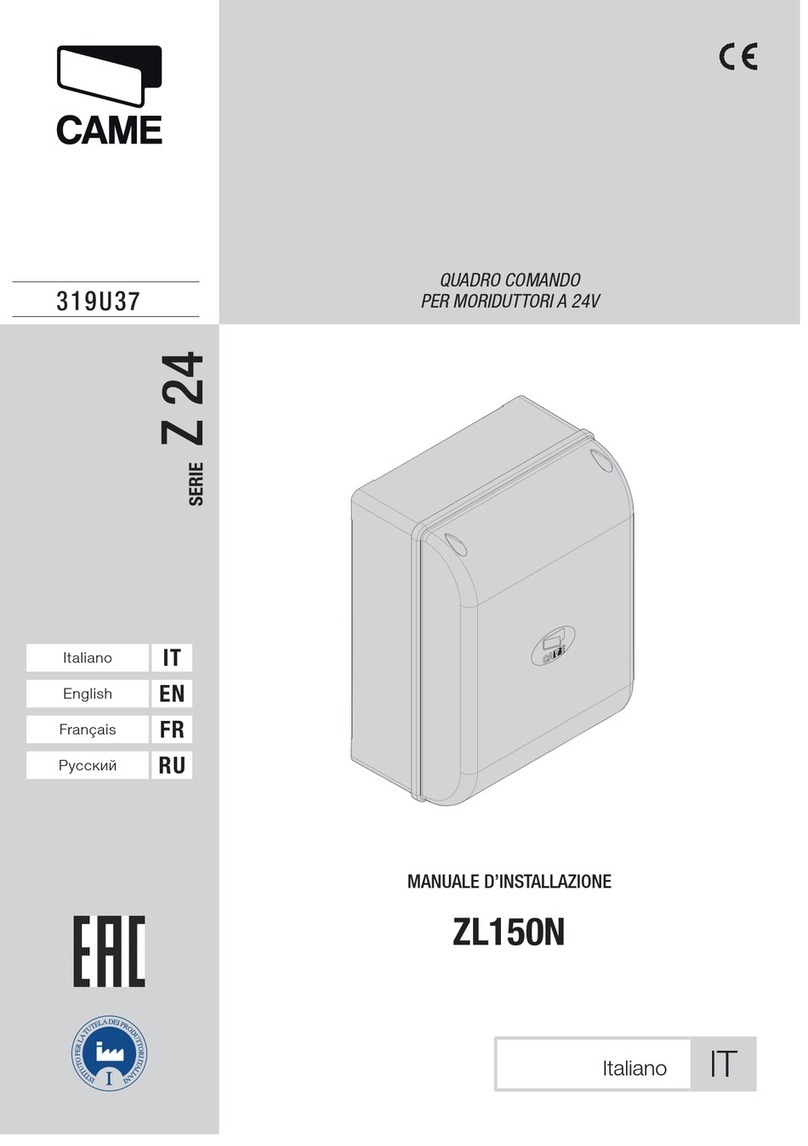
CAME
CAME Z 24 Series installation manual
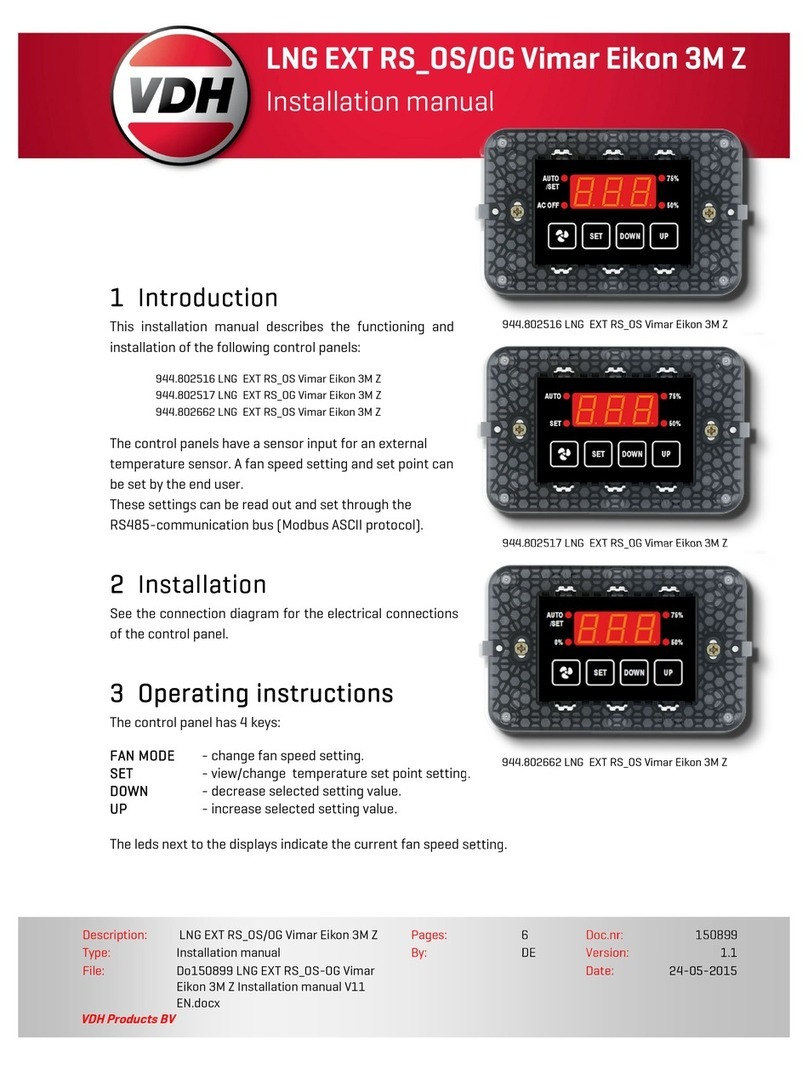
VDH
VDH LNG EXT RS_OS Vimar Eikon 3M Z installation manual
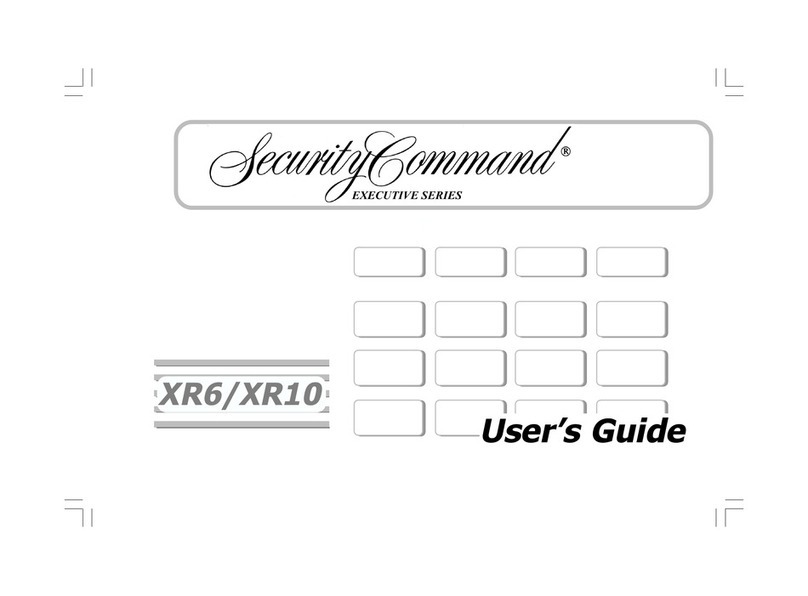
Security Command
Security Command XR6 user guide
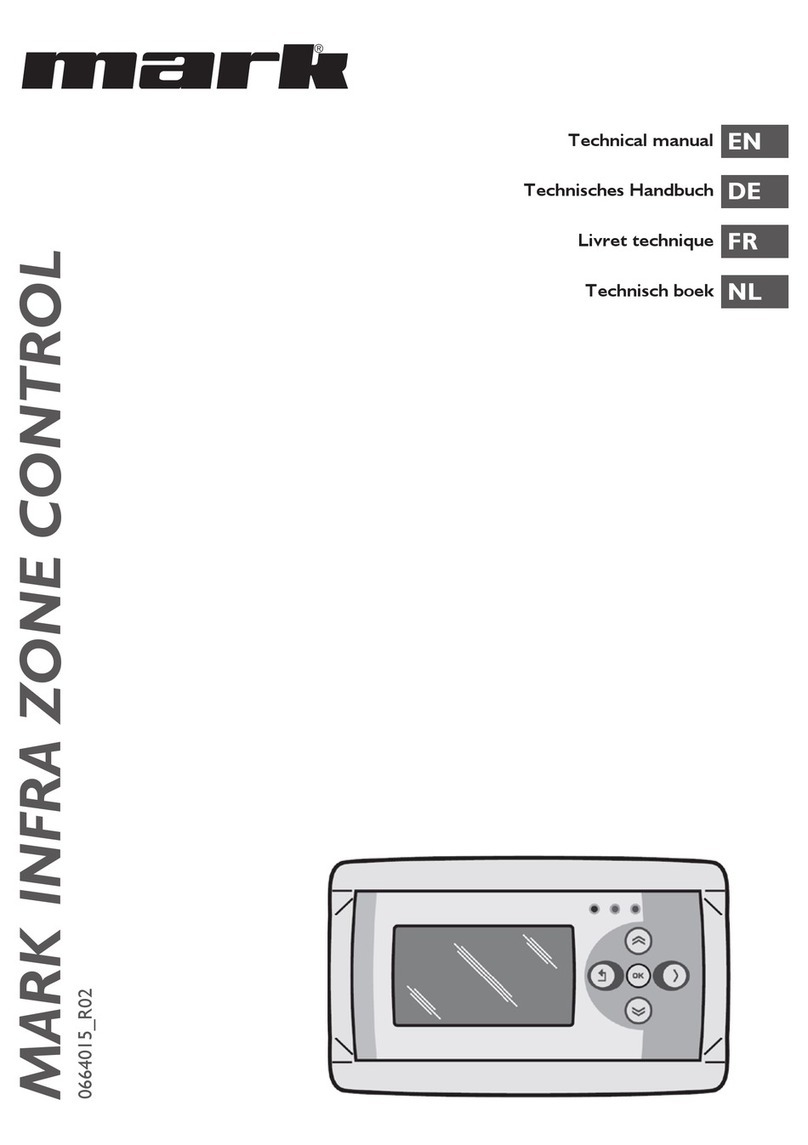
Mark
Mark Infra zone control Technical manual
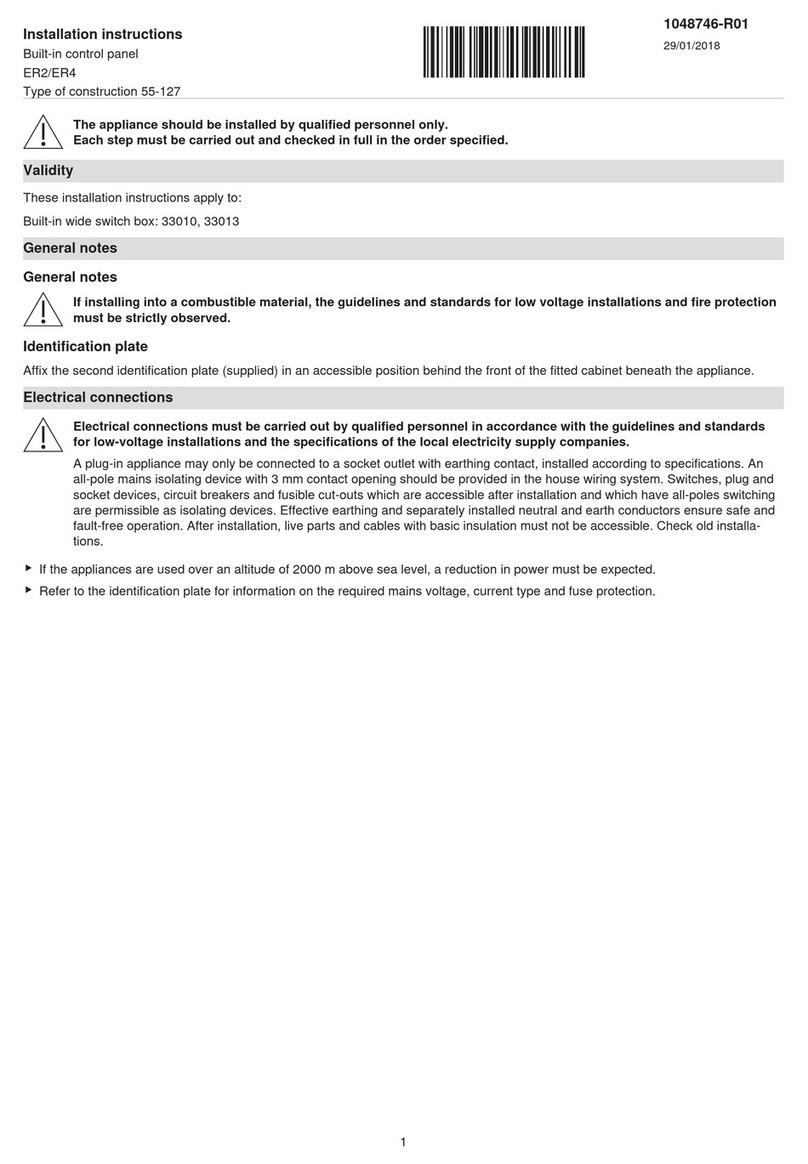
V-ZUG
V-ZUG ER2 installation instructions
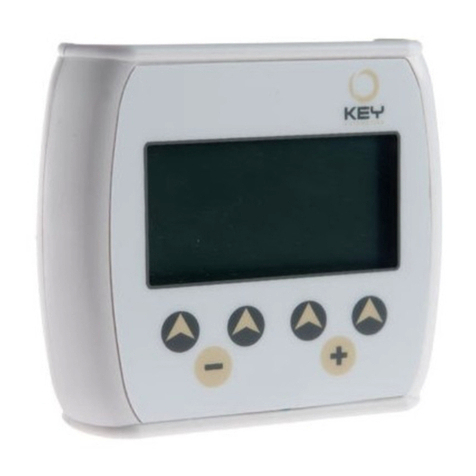
Keyautomation
Keyautomation EASY Instructions and warnings for installation and use
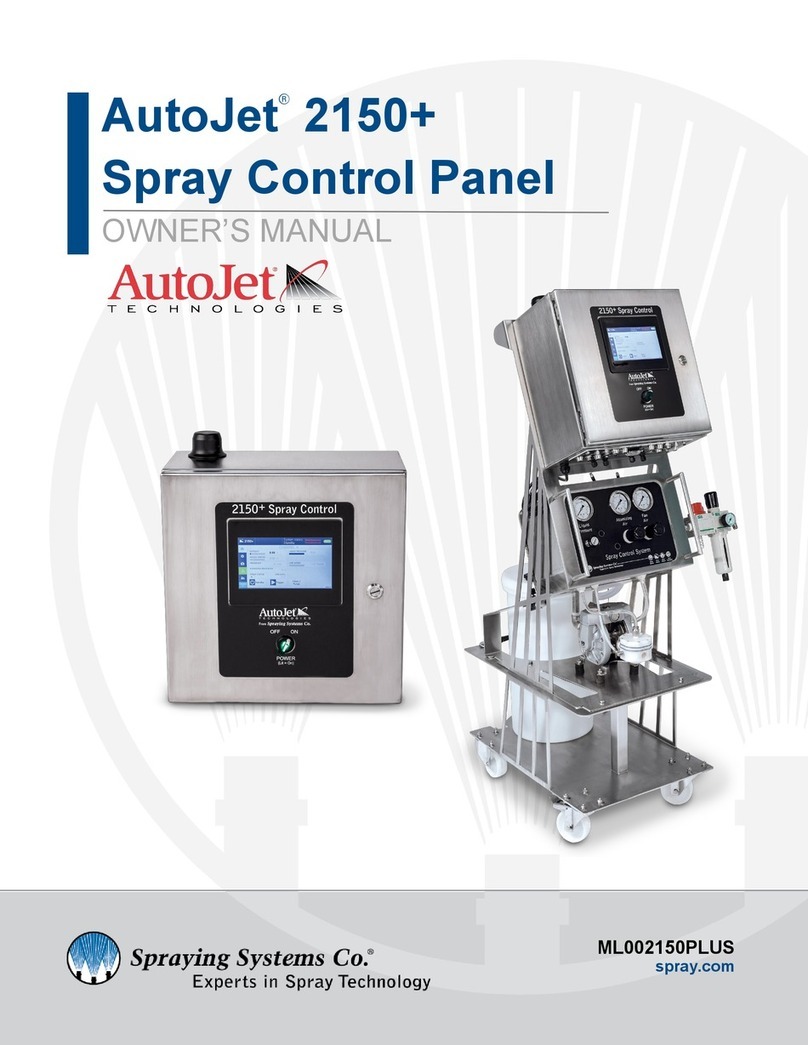
Spraying Systems
Spraying Systems AutoJet 2150+ owner's manual
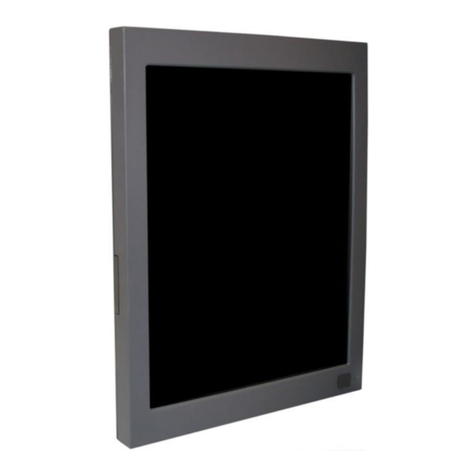
SIGMA TEK
SIGMA TEK ETV 1991 manual
